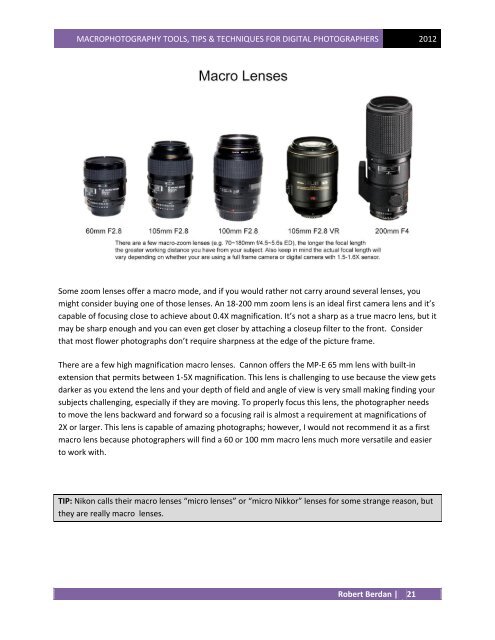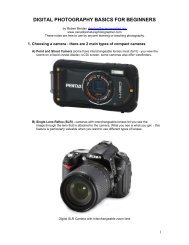Download PDF - The Canadian Nature Photographer
Download PDF - The Canadian Nature Photographer
Download PDF - The Canadian Nature Photographer
Create successful ePaper yourself
Turn your PDF publications into a flip-book with our unique Google optimized e-Paper software.
MACROPHOTOGRAPHY TOOLS, TIPS & TECHNIQUES FOR DIGITAL PHOTOGRAPHERS 2012<br />
Some zoom lenses offer a macro mode, and if you would rather not carry around several lenses, you<br />
might consider buying one of those lenses. An 18-200 mm zoom lens is an ideal first camera lens and it’s<br />
capable of focusing close to achieve about 0.4X magnification. It’s not a sharp as a true macro lens, but it<br />
may be sharp enough and you can even get closer by attaching a closeup filter to the front. Consider<br />
that most flower photographs don’t require sharpness at the edge of the picture frame.<br />
<strong>The</strong>re are a few high magnification macro lenses. Cannon offers the MP-E 65 mm lens with built-in<br />
extension that permits between 1-5X magnification. This lens is challenging to use because the view gets<br />
darker as you extend the lens and your depth of field and angle of view is very small making finding your<br />
subjects challenging, especially if they are moving. To properly focus this lens, the photographer needs<br />
to move the lens backward and forward so a focusing rail is almost a requirement at magnifications of<br />
2X or larger. This lens is capable of amazing photographs; however, I would not recommend it as a first<br />
macro lens because photographers will find a 60 or 100 mm macro lens much more versatile and easier<br />
to work with.<br />
TIP: Nikon calls their macro lenses “micro lenses” or “micro Nikkor” lenses for some strange reason, but<br />
they are really macro lenses.<br />
Robert Berdan | 21




